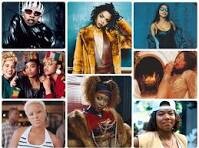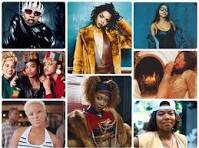
Thanks in part to iconic performers like Roxanne Shanté and Salt-N-Pepa, who established the groundwork for the female rap aesthetic, female rappers of the 1990s carried on the traditions that had begun to seep from 1980s hip-hop. While incorporating their distinct flare, Left Eye, Da Brat, and Queen Latifah’s styles were reminiscent of the macho aspects popular in this genre dominated by men.
Rappers such as Foxy Brown, Lil Kim, and Gangsta Boo, on the other hand, dared to defy expectations about what women should wear by choosing to wear skimpy, form-fitting clothes and baring their undergarments to match their songs. Female rappers did more than set trends, some of which persist. They transformed the rap industry as a whole, and here are some of the most influential female rappers of the 90s.
- Lauryn Hill
Lauryn Hill was acclaimed as a celebrity as soon as the 1994 Fugees album Blunted On Reality gave critics a taste of her talent. In a line from 1996’s The Score, fellow Fugee Wyclef Jean admitted as much, rapping, “The guys should stop rapping/Vanish like Menudo, the girl shoulda gone solo.”
In 1998, Hill went solo and released The Miseducation Of Lauryn Hill, a critical success. By fusing neo-soul beats with forceful feminist lyrics, Hill explored the complexities of black femininity, motherhood, womanhood, and the music industry. Songs like “Everything Is Everything,” “Doo Wop (That Thing),” “Ex-Factor,” and “Lost Ones.” are timeless hits that sound just as amazing now as they did when they were first released.
Although Hill hasn’t put out a record since a compilation in 2007, she is still unrivaled among the greatest female rappers of all time. The Miseducation of Lauryn Hill is her most successful project, and you should consider listening to it as you’re enjoying roulette at your favorite online casino on your day off.
- Missy Elliott
The legendary Missy Elliott made her bold and inventive style her own when she first appeared on the hip-hop scene in the mid-1990s. Renowned for her exceptional production abilities on standout songs like “Get Ur Freak On,” she emerged as a trailblazer within the industry.
Missy Elliott always pushed limits with her clever and thought-provoking songs, winning the respect and adoration of musicians and fans alike. She has undoubtedly become an iconic figure in the hall of fame of the ’90s hip-hop superstars, thanks to her unique style and overwhelming brilliance.
- MC LYTE
MC Lyte was a hip-hop pioneer who unquestionably had one of the most iconic looks of the 1990s. She expertly combined fashion elements from the 1980s and 1990s. She described her amorous inclinations and desires in songs like “Ruffneck” and “Poor George,” and her expressive, flowing manner provided the ideal counterpoint.
Her look incorporated varsity jackets, baseball hats, oversized tees, tracksuits, bright red lipstick, and gold door knocker earrings, primarily leaning toward more masculine styles.
- DA BRAT
Following the release of her debut album Funkdafied in 1994, Da Brat became the first female rapper to achieve platinum status and cemented her status as a style icon of the 1990s. Her flowing look embraced the styles that contributed to characterizing the hip-hop movement of the 1990s: fitting tanks and crop tops combined with leather jackets, baggy-fit jeans, flannels, and oversized tees.
Da Brat’s aesthetic was anchored in genuineness and effortlessness rather than trends, in contrast to other female rappers whose outfits frequently featured masculine characteristics. Da Brat’s complemented her androgynous look with her striking use of accessories, often rocking large twists of hair decorated with yarn, colorful rubber bands, and beads, which she presented as wearable hair art.
- Lil’ Kim
During the 1990s hip-hop era, Lil’ Kim gained notoriety for her audacious lyrics and unabashed manner. With her daring look and contentious subject matter, the petite dynamo defied expectations and demonstrated that women could compete with men.
It is impossible to overestimate Lil’ Kim’s influence on female empowerment and the rap game, as she opened the door for numerous female artists to accept their sexuality and have an independent presence in the hip-hop industry.
- Left Eye
Unquestionably ahead of her time, Lisa “Left Eye” Lopes made a lasting impact on pop culture and design. She was a part of the renowned R&B group TLC, and she, Chilli, and T-Boz would often coordinate their looks.
However, her independence was evident as she mesmerized listeners with her unconventional flair and unusually lively flow. Left Eye included unconventional and whimsical details in her looks, such as the exposed boxers, black stripe beneath her left eye, condom-framed glasses, and enormous hats.
Left Eye’s mesh layering shirts, graphic baby tees, asymmetrical tube tops, and shimmering slacks helped establish the framework for the Y2K look by the time of her death, which sadly occurred in 2002.
- Trina
When Trina first grabbed the attention of Miami rapper Trick Daddy in 1998 while pursuing her real estate license, he randomly chose her to feature on his song “Nann Nigga.” In 1998, Trick’s second studio album, www.thug.com, featured the lead track, which peaked at No. 3 on the Rap Songs list.
This feature launched Trina’s rap career, which resulted in a record deal with Slip-n-Slide Records and distribution from Atlantic Records. Two years later, she released her debut album, Da Baddest Bitch, and went on to create a career praised for its length and consistency.
Final Thoughts
While hip-hop was a male-dominated industry in the 90s (it still is), these female rappers established themselves as authorities, and to this day, their influence is still greatly felt.
© 2024, C Wood. All rights reserved.
Source link

